Case Study on Compartment Syndrome: Pathophysiology and Symptoms
VerifiedAdded on 2021/05/31
|9
|1915
|33
Case Study
AI Summary
This case study delves into the pathophysiology of compartment syndrome, an acute condition caused by increased pressure within a muscle compartment, leading to tissue ischemia, nerve damage, and potentially necrosis. The study highlights the anatomy of muscle compartments and the mechanisms by which swelling and increased interstitial pressure compromise blood circulation. It explores the causes of compartment syndrome, including fractures, injuries, and tight bandages, and emphasizes the importance of timely diagnosis and treatment, such as fasciotomy. The report details the cascade of cellular and molecular events involved, including inflammatory responses, increased capillary permeability, and the resulting ischemia. Clinical signs and symptoms, such as persistent pain, paresthesia, and swelling, are discussed, along with the potential for permanent disability if left untreated. The study concludes by emphasizing the severity of acute compartment syndrome and the need for prompt intervention to prevent long-term complications. The document references several research articles to support its claims.

Running head: COMPARTMENT SYNDROME
COMPARTMENT SYNDROME
Name of the Student
Name of the university
Author’s note
COMPARTMENT SYNDROME
Name of the Student
Name of the university
Author’s note
Paraphrase This Document
Need a fresh take? Get an instant paraphrase of this document with our AI Paraphraser
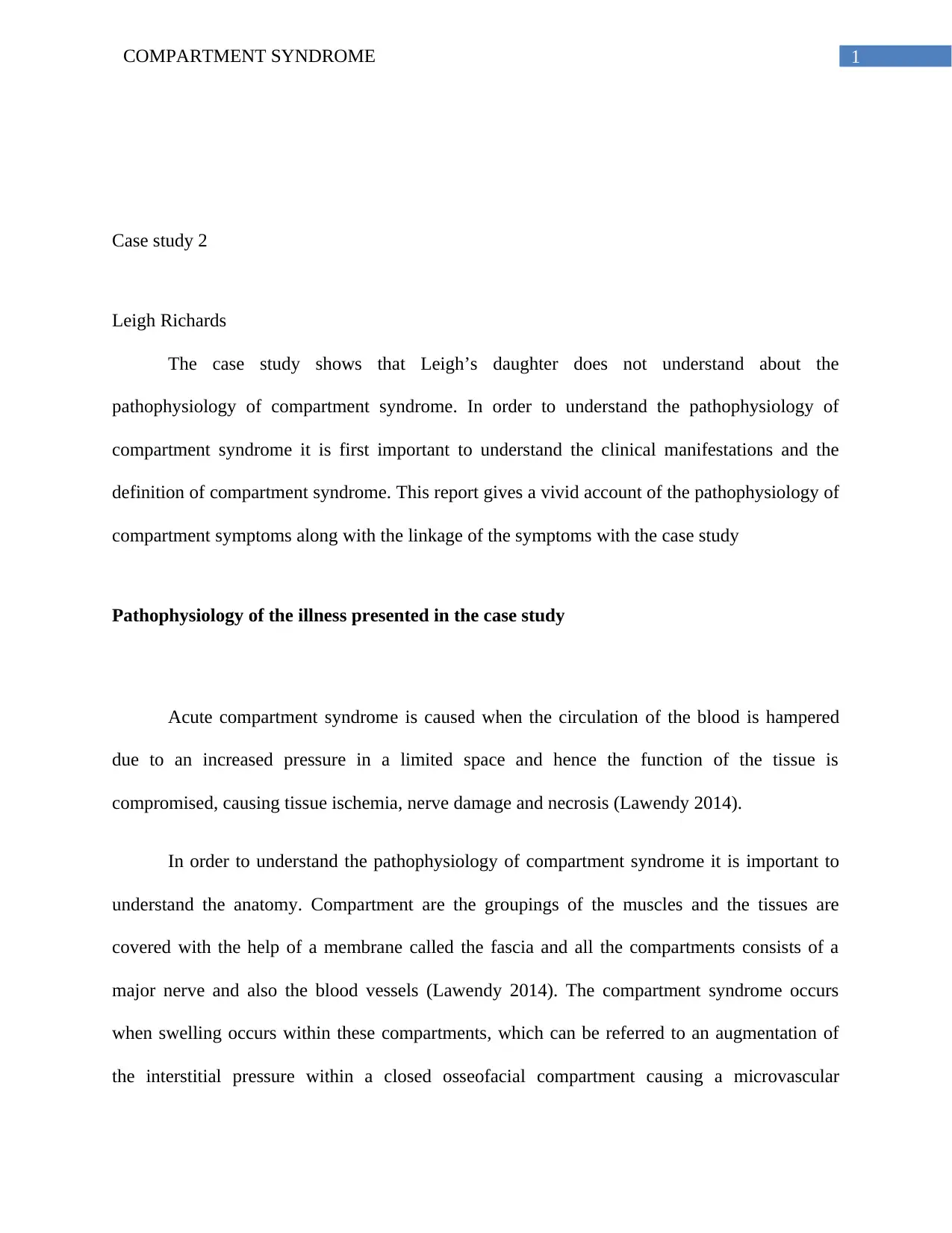
1COMPARTMENT SYNDROME
Case study 2
Leigh Richards
The case study shows that Leigh’s daughter does not understand about the
pathophysiology of compartment syndrome. In order to understand the pathophysiology of
compartment syndrome it is first important to understand the clinical manifestations and the
definition of compartment syndrome. This report gives a vivid account of the pathophysiology of
compartment symptoms along with the linkage of the symptoms with the case study
Pathophysiology of the illness presented in the case study
Acute compartment syndrome is caused when the circulation of the blood is hampered
due to an increased pressure in a limited space and hence the function of the tissue is
compromised, causing tissue ischemia, nerve damage and necrosis (Lawendy 2014).
In order to understand the pathophysiology of compartment syndrome it is important to
understand the anatomy. Compartment are the groupings of the muscles and the tissues are
covered with the help of a membrane called the fascia and all the compartments consists of a
major nerve and also the blood vessels (Lawendy 2014). The compartment syndrome occurs
when swelling occurs within these compartments, which can be referred to an augmentation of
the interstitial pressure within a closed osseofacial compartment causing a microvascular
Case study 2
Leigh Richards
The case study shows that Leigh’s daughter does not understand about the
pathophysiology of compartment syndrome. In order to understand the pathophysiology of
compartment syndrome it is first important to understand the clinical manifestations and the
definition of compartment syndrome. This report gives a vivid account of the pathophysiology of
compartment symptoms along with the linkage of the symptoms with the case study
Pathophysiology of the illness presented in the case study
Acute compartment syndrome is caused when the circulation of the blood is hampered
due to an increased pressure in a limited space and hence the function of the tissue is
compromised, causing tissue ischemia, nerve damage and necrosis (Lawendy 2014).
In order to understand the pathophysiology of compartment syndrome it is important to
understand the anatomy. Compartment are the groupings of the muscles and the tissues are
covered with the help of a membrane called the fascia and all the compartments consists of a
major nerve and also the blood vessels (Lawendy 2014). The compartment syndrome occurs
when swelling occurs within these compartments, which can be referred to an augmentation of
the interstitial pressure within a closed osseofacial compartment causing a microvascular
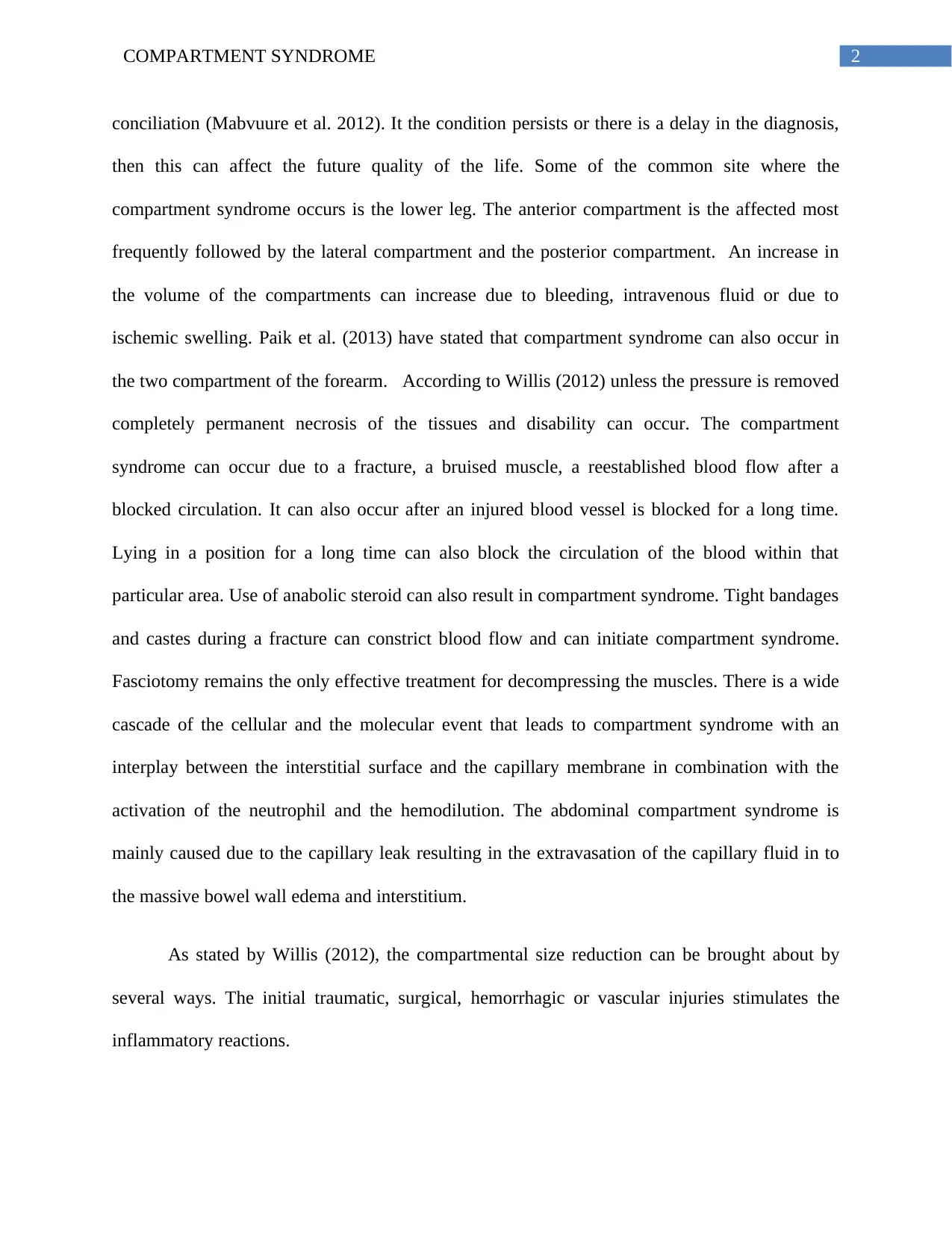
2COMPARTMENT SYNDROME
conciliation (Mabvuure et al. 2012). It the condition persists or there is a delay in the diagnosis,
then this can affect the future quality of the life. Some of the common site where the
compartment syndrome occurs is the lower leg. The anterior compartment is the affected most
frequently followed by the lateral compartment and the posterior compartment. An increase in
the volume of the compartments can increase due to bleeding, intravenous fluid or due to
ischemic swelling. Paik et al. (2013) have stated that compartment syndrome can also occur in
the two compartment of the forearm. According to Willis (2012) unless the pressure is removed
completely permanent necrosis of the tissues and disability can occur. The compartment
syndrome can occur due to a fracture, a bruised muscle, a reestablished blood flow after a
blocked circulation. It can also occur after an injured blood vessel is blocked for a long time.
Lying in a position for a long time can also block the circulation of the blood within that
particular area. Use of anabolic steroid can also result in compartment syndrome. Tight bandages
and castes during a fracture can constrict blood flow and can initiate compartment syndrome.
Fasciotomy remains the only effective treatment for decompressing the muscles. There is a wide
cascade of the cellular and the molecular event that leads to compartment syndrome with an
interplay between the interstitial surface and the capillary membrane in combination with the
activation of the neutrophil and the hemodilution. The abdominal compartment syndrome is
mainly caused due to the capillary leak resulting in the extravasation of the capillary fluid in to
the massive bowel wall edema and interstitium.
As stated by Willis (2012), the compartmental size reduction can be brought about by
several ways. The initial traumatic, surgical, hemorrhagic or vascular injuries stimulates the
inflammatory reactions.
conciliation (Mabvuure et al. 2012). It the condition persists or there is a delay in the diagnosis,
then this can affect the future quality of the life. Some of the common site where the
compartment syndrome occurs is the lower leg. The anterior compartment is the affected most
frequently followed by the lateral compartment and the posterior compartment. An increase in
the volume of the compartments can increase due to bleeding, intravenous fluid or due to
ischemic swelling. Paik et al. (2013) have stated that compartment syndrome can also occur in
the two compartment of the forearm. According to Willis (2012) unless the pressure is removed
completely permanent necrosis of the tissues and disability can occur. The compartment
syndrome can occur due to a fracture, a bruised muscle, a reestablished blood flow after a
blocked circulation. It can also occur after an injured blood vessel is blocked for a long time.
Lying in a position for a long time can also block the circulation of the blood within that
particular area. Use of anabolic steroid can also result in compartment syndrome. Tight bandages
and castes during a fracture can constrict blood flow and can initiate compartment syndrome.
Fasciotomy remains the only effective treatment for decompressing the muscles. There is a wide
cascade of the cellular and the molecular event that leads to compartment syndrome with an
interplay between the interstitial surface and the capillary membrane in combination with the
activation of the neutrophil and the hemodilution. The abdominal compartment syndrome is
mainly caused due to the capillary leak resulting in the extravasation of the capillary fluid in to
the massive bowel wall edema and interstitium.
As stated by Willis (2012), the compartmental size reduction can be brought about by
several ways. The initial traumatic, surgical, hemorrhagic or vascular injuries stimulates the
inflammatory reactions.
⊘ This is a preview!⊘
Do you want full access?
Subscribe today to unlock all pages.

Trusted by 1+ million students worldwide
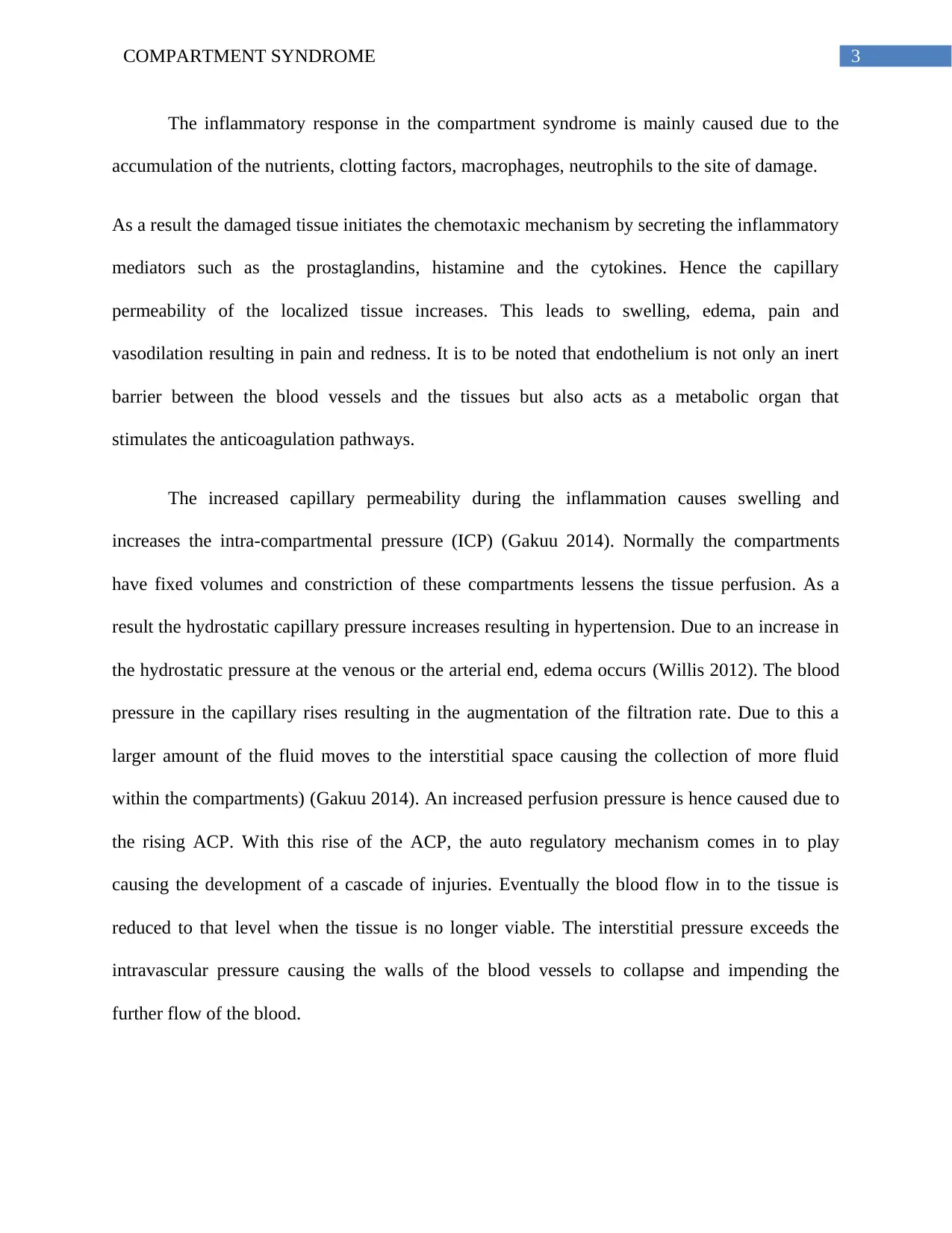
3COMPARTMENT SYNDROME
The inflammatory response in the compartment syndrome is mainly caused due to the
accumulation of the nutrients, clotting factors, macrophages, neutrophils to the site of damage.
As a result the damaged tissue initiates the chemotaxic mechanism by secreting the inflammatory
mediators such as the prostaglandins, histamine and the cytokines. Hence the capillary
permeability of the localized tissue increases. This leads to swelling, edema, pain and
vasodilation resulting in pain and redness. It is to be noted that endothelium is not only an inert
barrier between the blood vessels and the tissues but also acts as a metabolic organ that
stimulates the anticoagulation pathways.
The increased capillary permeability during the inflammation causes swelling and
increases the intra-compartmental pressure (ICP) (Gakuu 2014). Normally the compartments
have fixed volumes and constriction of these compartments lessens the tissue perfusion. As a
result the hydrostatic capillary pressure increases resulting in hypertension. Due to an increase in
the hydrostatic pressure at the venous or the arterial end, edema occurs (Willis 2012). The blood
pressure in the capillary rises resulting in the augmentation of the filtration rate. Due to this a
larger amount of the fluid moves to the interstitial space causing the collection of more fluid
within the compartments) (Gakuu 2014). An increased perfusion pressure is hence caused due to
the rising ACP. With this rise of the ACP, the auto regulatory mechanism comes in to play
causing the development of a cascade of injuries. Eventually the blood flow in to the tissue is
reduced to that level when the tissue is no longer viable. The interstitial pressure exceeds the
intravascular pressure causing the walls of the blood vessels to collapse and impending the
further flow of the blood.
The inflammatory response in the compartment syndrome is mainly caused due to the
accumulation of the nutrients, clotting factors, macrophages, neutrophils to the site of damage.
As a result the damaged tissue initiates the chemotaxic mechanism by secreting the inflammatory
mediators such as the prostaglandins, histamine and the cytokines. Hence the capillary
permeability of the localized tissue increases. This leads to swelling, edema, pain and
vasodilation resulting in pain and redness. It is to be noted that endothelium is not only an inert
barrier between the blood vessels and the tissues but also acts as a metabolic organ that
stimulates the anticoagulation pathways.
The increased capillary permeability during the inflammation causes swelling and
increases the intra-compartmental pressure (ICP) (Gakuu 2014). Normally the compartments
have fixed volumes and constriction of these compartments lessens the tissue perfusion. As a
result the hydrostatic capillary pressure increases resulting in hypertension. Due to an increase in
the hydrostatic pressure at the venous or the arterial end, edema occurs (Willis 2012). The blood
pressure in the capillary rises resulting in the augmentation of the filtration rate. Due to this a
larger amount of the fluid moves to the interstitial space causing the collection of more fluid
within the compartments) (Gakuu 2014). An increased perfusion pressure is hence caused due to
the rising ACP. With this rise of the ACP, the auto regulatory mechanism comes in to play
causing the development of a cascade of injuries. Eventually the blood flow in to the tissue is
reduced to that level when the tissue is no longer viable. The interstitial pressure exceeds the
intravascular pressure causing the walls of the blood vessels to collapse and impending the
further flow of the blood.
Paraphrase This Document
Need a fresh take? Get an instant paraphrase of this document with our AI Paraphraser
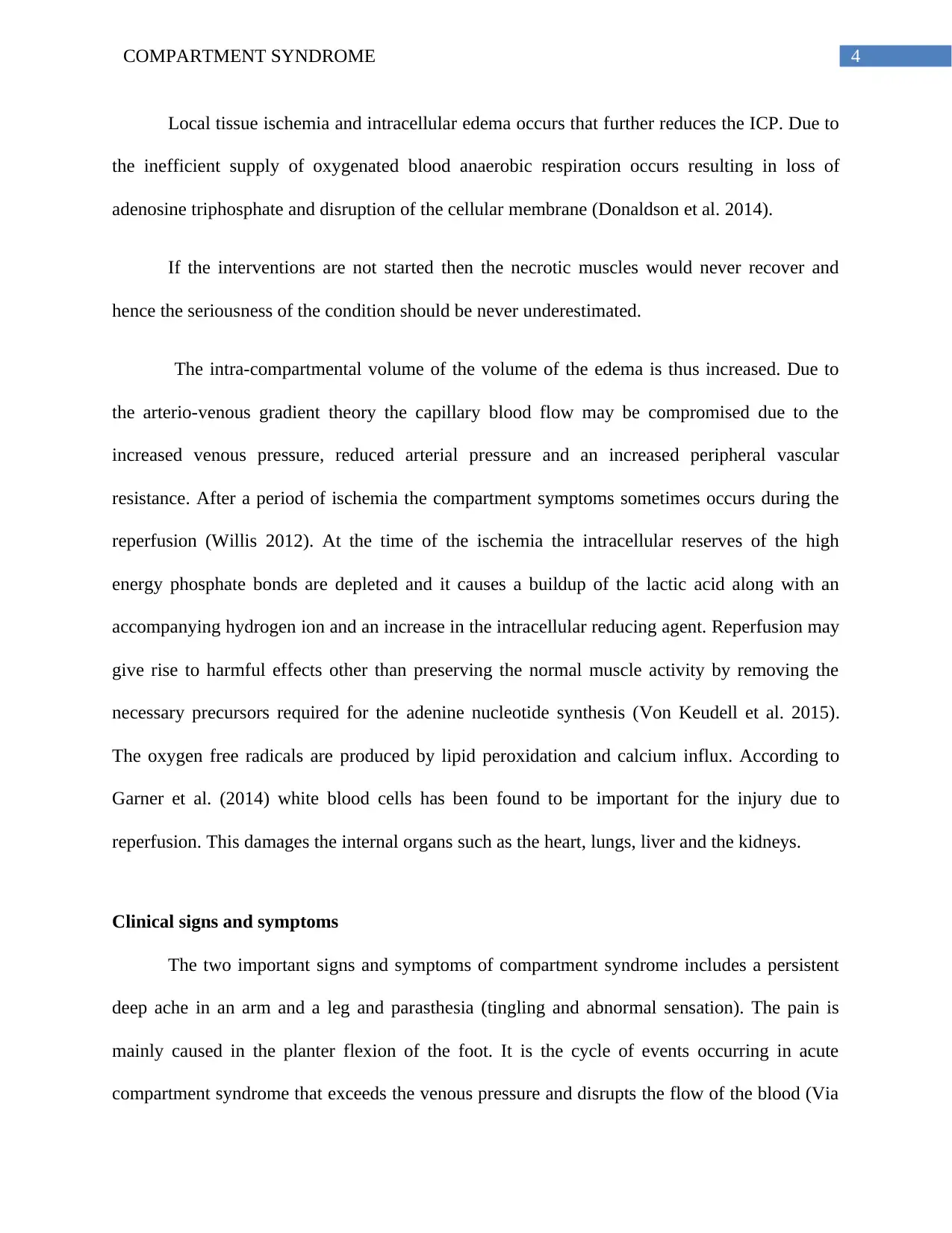
4COMPARTMENT SYNDROME
Local tissue ischemia and intracellular edema occurs that further reduces the ICP. Due to
the inefficient supply of oxygenated blood anaerobic respiration occurs resulting in loss of
adenosine triphosphate and disruption of the cellular membrane (Donaldson et al. 2014).
If the interventions are not started then the necrotic muscles would never recover and
hence the seriousness of the condition should be never underestimated.
The intra-compartmental volume of the volume of the edema is thus increased. Due to
the arterio-venous gradient theory the capillary blood flow may be compromised due to the
increased venous pressure, reduced arterial pressure and an increased peripheral vascular
resistance. After a period of ischemia the compartment symptoms sometimes occurs during the
reperfusion (Willis 2012). At the time of the ischemia the intracellular reserves of the high
energy phosphate bonds are depleted and it causes a buildup of the lactic acid along with an
accompanying hydrogen ion and an increase in the intracellular reducing agent. Reperfusion may
give rise to harmful effects other than preserving the normal muscle activity by removing the
necessary precursors required for the adenine nucleotide synthesis (Von Keudell et al. 2015).
The oxygen free radicals are produced by lipid peroxidation and calcium influx. According to
Garner et al. (2014) white blood cells has been found to be important for the injury due to
reperfusion. This damages the internal organs such as the heart, lungs, liver and the kidneys.
Clinical signs and symptoms
The two important signs and symptoms of compartment syndrome includes a persistent
deep ache in an arm and a leg and parasthesia (tingling and abnormal sensation). The pain is
mainly caused in the planter flexion of the foot. It is the cycle of events occurring in acute
compartment syndrome that exceeds the venous pressure and disrupts the flow of the blood (Via
Local tissue ischemia and intracellular edema occurs that further reduces the ICP. Due to
the inefficient supply of oxygenated blood anaerobic respiration occurs resulting in loss of
adenosine triphosphate and disruption of the cellular membrane (Donaldson et al. 2014).
If the interventions are not started then the necrotic muscles would never recover and
hence the seriousness of the condition should be never underestimated.
The intra-compartmental volume of the volume of the edema is thus increased. Due to
the arterio-venous gradient theory the capillary blood flow may be compromised due to the
increased venous pressure, reduced arterial pressure and an increased peripheral vascular
resistance. After a period of ischemia the compartment symptoms sometimes occurs during the
reperfusion (Willis 2012). At the time of the ischemia the intracellular reserves of the high
energy phosphate bonds are depleted and it causes a buildup of the lactic acid along with an
accompanying hydrogen ion and an increase in the intracellular reducing agent. Reperfusion may
give rise to harmful effects other than preserving the normal muscle activity by removing the
necessary precursors required for the adenine nucleotide synthesis (Von Keudell et al. 2015).
The oxygen free radicals are produced by lipid peroxidation and calcium influx. According to
Garner et al. (2014) white blood cells has been found to be important for the injury due to
reperfusion. This damages the internal organs such as the heart, lungs, liver and the kidneys.
Clinical signs and symptoms
The two important signs and symptoms of compartment syndrome includes a persistent
deep ache in an arm and a leg and parasthesia (tingling and abnormal sensation). The pain is
mainly caused in the planter flexion of the foot. It is the cycle of events occurring in acute
compartment syndrome that exceeds the venous pressure and disrupts the flow of the blood (Via
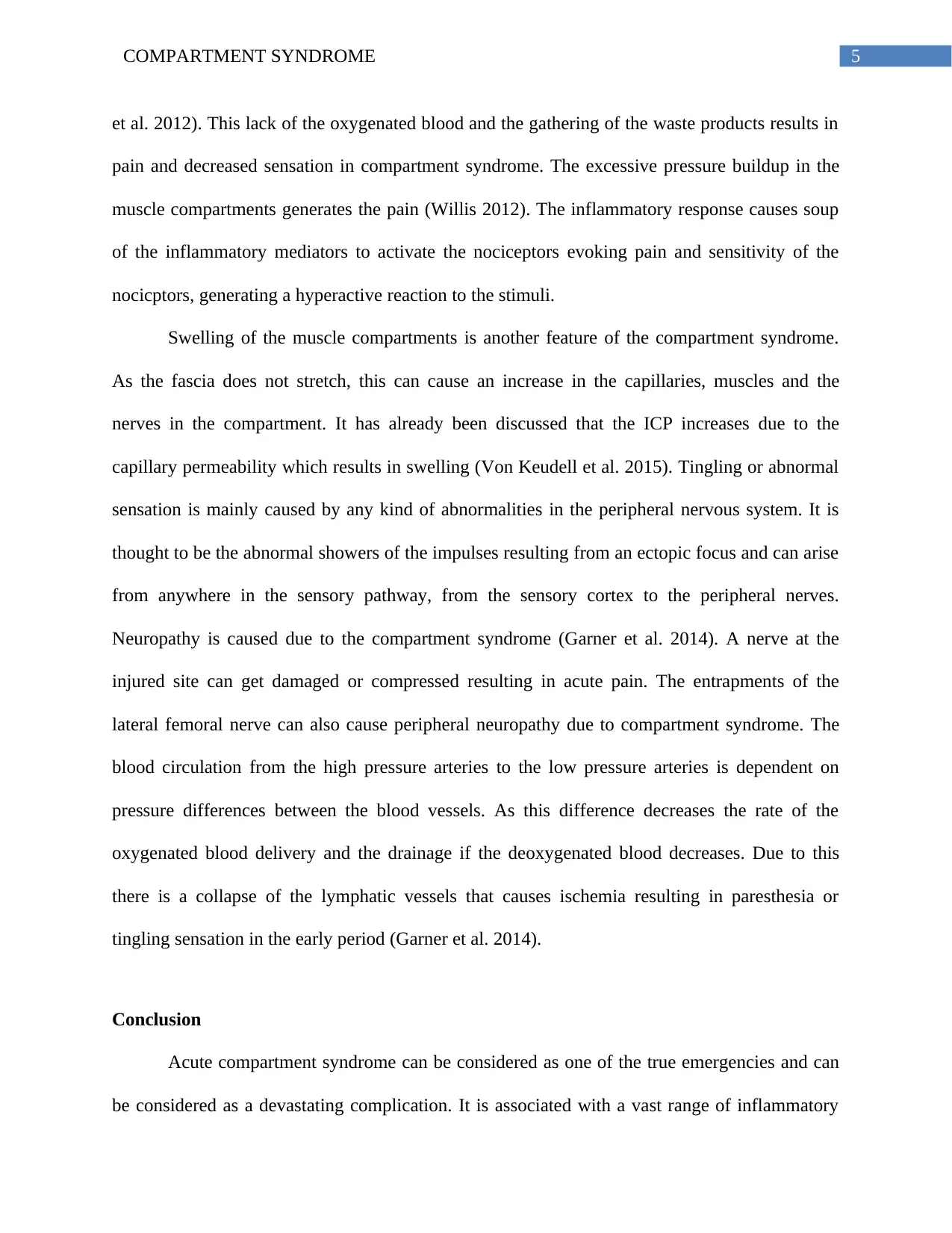
5COMPARTMENT SYNDROME
et al. 2012). This lack of the oxygenated blood and the gathering of the waste products results in
pain and decreased sensation in compartment syndrome. The excessive pressure buildup in the
muscle compartments generates the pain (Willis 2012). The inflammatory response causes soup
of the inflammatory mediators to activate the nociceptors evoking pain and sensitivity of the
nocicptors, generating a hyperactive reaction to the stimuli.
Swelling of the muscle compartments is another feature of the compartment syndrome.
As the fascia does not stretch, this can cause an increase in the capillaries, muscles and the
nerves in the compartment. It has already been discussed that the ICP increases due to the
capillary permeability which results in swelling (Von Keudell et al. 2015). Tingling or abnormal
sensation is mainly caused by any kind of abnormalities in the peripheral nervous system. It is
thought to be the abnormal showers of the impulses resulting from an ectopic focus and can arise
from anywhere in the sensory pathway, from the sensory cortex to the peripheral nerves.
Neuropathy is caused due to the compartment syndrome (Garner et al. 2014). A nerve at the
injured site can get damaged or compressed resulting in acute pain. The entrapments of the
lateral femoral nerve can also cause peripheral neuropathy due to compartment syndrome. The
blood circulation from the high pressure arteries to the low pressure arteries is dependent on
pressure differences between the blood vessels. As this difference decreases the rate of the
oxygenated blood delivery and the drainage if the deoxygenated blood decreases. Due to this
there is a collapse of the lymphatic vessels that causes ischemia resulting in paresthesia or
tingling sensation in the early period (Garner et al. 2014).
Conclusion
Acute compartment syndrome can be considered as one of the true emergencies and can
be considered as a devastating complication. It is associated with a vast range of inflammatory
et al. 2012). This lack of the oxygenated blood and the gathering of the waste products results in
pain and decreased sensation in compartment syndrome. The excessive pressure buildup in the
muscle compartments generates the pain (Willis 2012). The inflammatory response causes soup
of the inflammatory mediators to activate the nociceptors evoking pain and sensitivity of the
nocicptors, generating a hyperactive reaction to the stimuli.
Swelling of the muscle compartments is another feature of the compartment syndrome.
As the fascia does not stretch, this can cause an increase in the capillaries, muscles and the
nerves in the compartment. It has already been discussed that the ICP increases due to the
capillary permeability which results in swelling (Von Keudell et al. 2015). Tingling or abnormal
sensation is mainly caused by any kind of abnormalities in the peripheral nervous system. It is
thought to be the abnormal showers of the impulses resulting from an ectopic focus and can arise
from anywhere in the sensory pathway, from the sensory cortex to the peripheral nerves.
Neuropathy is caused due to the compartment syndrome (Garner et al. 2014). A nerve at the
injured site can get damaged or compressed resulting in acute pain. The entrapments of the
lateral femoral nerve can also cause peripheral neuropathy due to compartment syndrome. The
blood circulation from the high pressure arteries to the low pressure arteries is dependent on
pressure differences between the blood vessels. As this difference decreases the rate of the
oxygenated blood delivery and the drainage if the deoxygenated blood decreases. Due to this
there is a collapse of the lymphatic vessels that causes ischemia resulting in paresthesia or
tingling sensation in the early period (Garner et al. 2014).
Conclusion
Acute compartment syndrome can be considered as one of the true emergencies and can
be considered as a devastating complication. It is associated with a vast range of inflammatory
⊘ This is a preview!⊘
Do you want full access?
Subscribe today to unlock all pages.

Trusted by 1+ million students worldwide

6COMPARTMENT SYNDROME
cascade that results in decreased blood flow in the muscles and finally muscle necrosis. If left
untreated can lead to permanent disabilities. The treatments involves switching in to new
methods of diagnosis and proper prophylactic and fasciotomy.
cascade that results in decreased blood flow in the muscles and finally muscle necrosis. If left
untreated can lead to permanent disabilities. The treatments involves switching in to new
methods of diagnosis and proper prophylactic and fasciotomy.
Paraphrase This Document
Need a fresh take? Get an instant paraphrase of this document with our AI Paraphraser
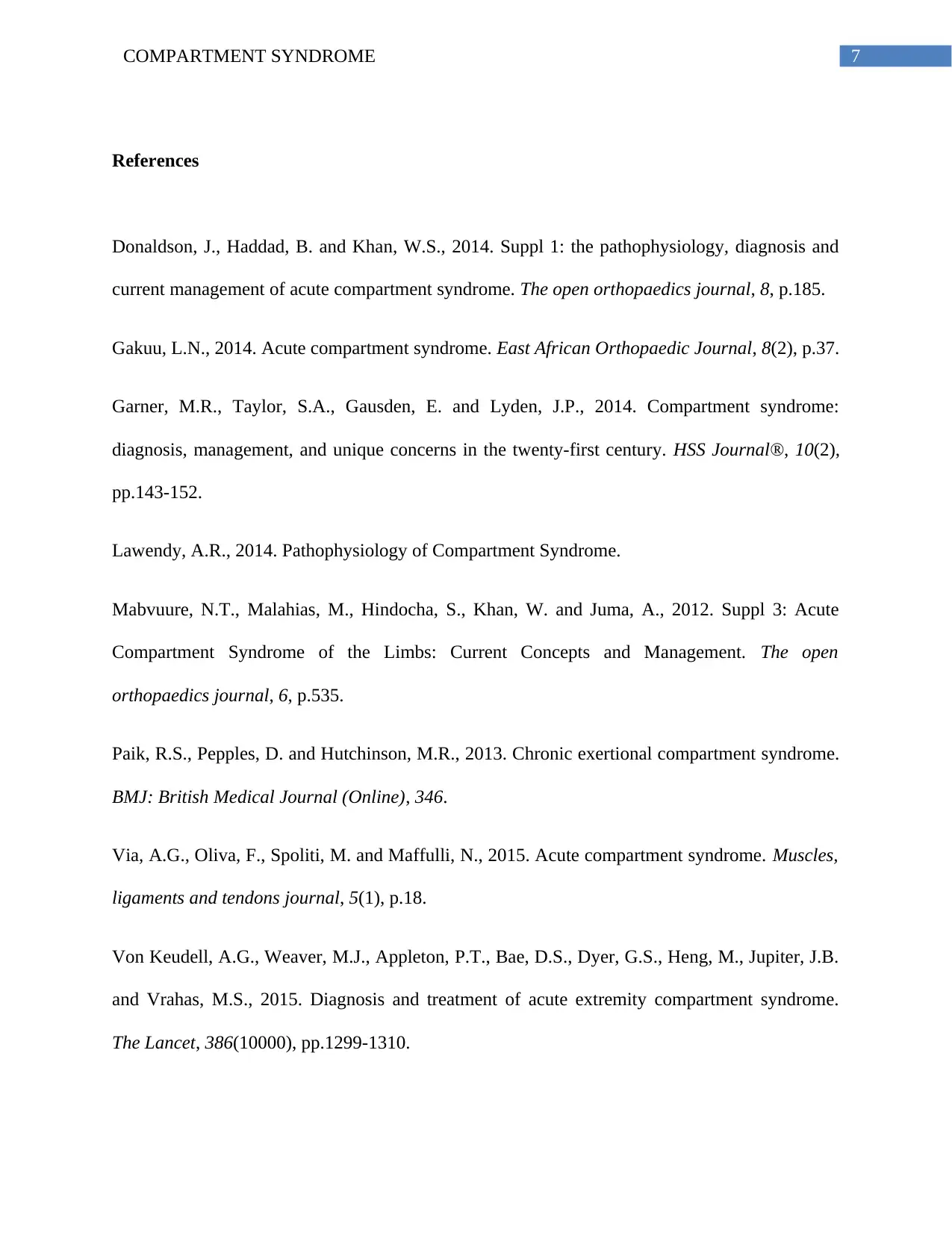
7COMPARTMENT SYNDROME
References
Donaldson, J., Haddad, B. and Khan, W.S., 2014. Suppl 1: the pathophysiology, diagnosis and
current management of acute compartment syndrome. The open orthopaedics journal, 8, p.185.
Gakuu, L.N., 2014. Acute compartment syndrome. East African Orthopaedic Journal, 8(2), p.37.
Garner, M.R., Taylor, S.A., Gausden, E. and Lyden, J.P., 2014. Compartment syndrome:
diagnosis, management, and unique concerns in the twenty-first century. HSS Journal®, 10(2),
pp.143-152.
Lawendy, A.R., 2014. Pathophysiology of Compartment Syndrome.
Mabvuure, N.T., Malahias, M., Hindocha, S., Khan, W. and Juma, A., 2012. Suppl 3: Acute
Compartment Syndrome of the Limbs: Current Concepts and Management. The open
orthopaedics journal, 6, p.535.
Paik, R.S., Pepples, D. and Hutchinson, M.R., 2013. Chronic exertional compartment syndrome.
BMJ: British Medical Journal (Online), 346.
Via, A.G., Oliva, F., Spoliti, M. and Maffulli, N., 2015. Acute compartment syndrome. Muscles,
ligaments and tendons journal, 5(1), p.18.
Von Keudell, A.G., Weaver, M.J., Appleton, P.T., Bae, D.S., Dyer, G.S., Heng, M., Jupiter, J.B.
and Vrahas, M.S., 2015. Diagnosis and treatment of acute extremity compartment syndrome.
The Lancet, 386(10000), pp.1299-1310.
References
Donaldson, J., Haddad, B. and Khan, W.S., 2014. Suppl 1: the pathophysiology, diagnosis and
current management of acute compartment syndrome. The open orthopaedics journal, 8, p.185.
Gakuu, L.N., 2014. Acute compartment syndrome. East African Orthopaedic Journal, 8(2), p.37.
Garner, M.R., Taylor, S.A., Gausden, E. and Lyden, J.P., 2014. Compartment syndrome:
diagnosis, management, and unique concerns in the twenty-first century. HSS Journal®, 10(2),
pp.143-152.
Lawendy, A.R., 2014. Pathophysiology of Compartment Syndrome.
Mabvuure, N.T., Malahias, M., Hindocha, S., Khan, W. and Juma, A., 2012. Suppl 3: Acute
Compartment Syndrome of the Limbs: Current Concepts and Management. The open
orthopaedics journal, 6, p.535.
Paik, R.S., Pepples, D. and Hutchinson, M.R., 2013. Chronic exertional compartment syndrome.
BMJ: British Medical Journal (Online), 346.
Via, A.G., Oliva, F., Spoliti, M. and Maffulli, N., 2015. Acute compartment syndrome. Muscles,
ligaments and tendons journal, 5(1), p.18.
Von Keudell, A.G., Weaver, M.J., Appleton, P.T., Bae, D.S., Dyer, G.S., Heng, M., Jupiter, J.B.
and Vrahas, M.S., 2015. Diagnosis and treatment of acute extremity compartment syndrome.
The Lancet, 386(10000), pp.1299-1310.

8COMPARTMENT SYNDROME
Willis, B., 2012. Compartment Syndrome. In Pediatric Orthopedic Surgical Emergencies (pp.
29-39). Springer, New York, NY.
Willis, B., 2012. Compartment Syndrome. In Pediatric Orthopedic Surgical Emergencies (pp.
29-39). Springer, New York, NY.
⊘ This is a preview!⊘
Do you want full access?
Subscribe today to unlock all pages.

Trusted by 1+ million students worldwide
1 out of 9
Related Documents
Your All-in-One AI-Powered Toolkit for Academic Success.
+13062052269
info@desklib.com
Available 24*7 on WhatsApp / Email
![[object Object]](/_next/static/media/star-bottom.7253800d.svg)
Unlock your academic potential
Copyright © 2020–2025 A2Z Services. All Rights Reserved. Developed and managed by ZUCOL.





